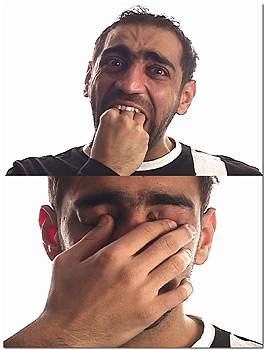Orange County Museum of Art,
Oct 01, 2006 - Dec 31, 2006
Newport Beach, Ca, USA
California Biennial, 2006
by Jennifer Wulffson
Biennial exhibitions are a tricky business and often people either seem to root for them or harbor antipathy before the show so much as opens. Biennial exhibitions with thematic content are arguably even trickier. The curators of the 2006 California Biennial - Elizabeth Armstrong, Rita Gonzalez, and Karen Moss --identified six themes running throughout the more than 125 works they chose to include, representing the efforts of more than 30 artists. "[T]he most significant tendencies in contemporary art made in California"(1) are described as: fantasy verité, historical and archival consciousness, social interaction, urban ecologies, adaptive identities, and extreme object making. Since these categories overlap, the curators have placed the work of some artists within multiple trends. The curators cannot be faulted for seeking - and finding - these common threads and strains, and the viewer, if he or she is aware of the loose categories, can feel satisfaction in discovering them while visiting the exhibition. But do the meanings of these categories have specific relevance to art being made now in California? Or are these themes common throughout the United States, or even internationally, in the present moment, revealing the art of California as more global in character, rather than strictly provincial, as this show may appear to claim? After all, these California biennial artists may currently work and reside in California, but they hail originally from all over the globe, with the majority beginning their education outside of California before coming to the state, often for the purpose of earning a MFA degree from a California school. Returning briefly to the idea of ’rooting for’ the California Biennial: there is much to root for in California art-wise, with premier art schools throughout the state and Los Angeles’ thriving gallery scene (coming in at a solid second place to New York to most minds). While mixed feelings about the current biennial, the ninth such exhibition to be held at the Orange County Museum of Art, might predominate, there are striking contributions here, with the most laudable aspect of the majority of work being its earnest political content. Such work is at its best when subtlety and strength of both practice and voice balance one another, rendering the work visually potent. Some of the work may have been more successful in this viewing if it had more space, as some galleries seemed overly crammed. This was, after all, the largest California Biennial to date. Works placed in the lobby area seemed to struggle at times but this was more a function of placement than of the works themselves: you are supposed to sit on the luxe sofas of Kianga Ford’s Urban Revival (2005), (although you may not be able to hear the accompanying audio) but nearby an 8 - by 11 inch piece of white paper on part of Christian Maychack’s sculptural installation From Here It Will Be Everything (2006), reads: "Please do not sit on bench", perhaps a necessary late addition after an accident or near miss, but this signage nevertheless mars the piece. When work was given the space it deserved, the viewing experience was less confused and more involved, as with Shana Lutker’s and Binh Danh’s installations. A component of Shana Lutker’s installation Excerpts (May have) (2006), was the double entendre-titled Dream House #2, a tabletop model of a house populated exclusively by maquettes of art objects the artist dreamed she had made. For instance, there is a large Corinthian capital, a Mayan-looking temple, a Richard Long-like installation of stones, and a seemingly Beuys-inspired object, all strangely presided over by a black watchtower from the Manzanar internment camp peeking out of the second story. Domesticity and dreaminess were also evoked in other parts of the installation: Lutker’s daily dream journals from 2003 and 2004
|













